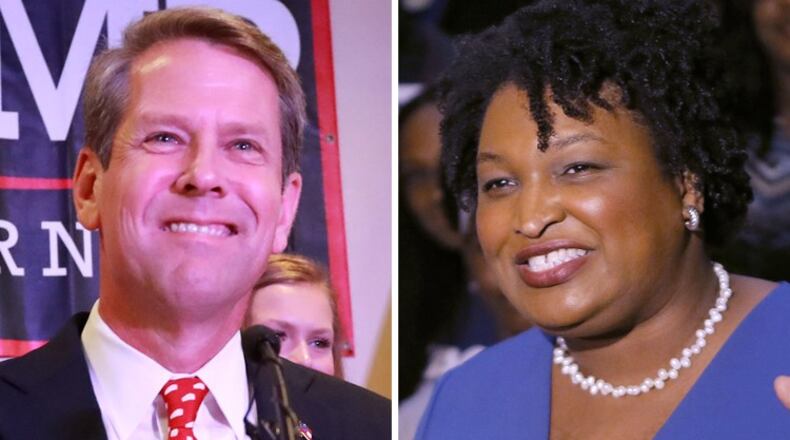Stacey Abrams needs to reach deep into the vast pool of left-leaning voters who rarely cast ballots in midterm elections. Brian Kemp aims to wring out every conservative vote he can. And they both intend to relentlessly appeal to skeptical independents who skipped the primaries.
Each candidate for governor faces complicated electoral math as the race nears the final two-month frenzy that begins after the Labor Day holiday. And both will steadily step up the tightrope act of energizing their bases while also trying to broaden their coalition of support.
The few public polls that have emerged since the general election matchup was set reflect a consistent theme: Partisan voters are retreating to their corners, while independents — traditionally a large bloc of Republican-leaning voters in Georgia — are up for grabs.
Kemp’s path to victory starts with the blueprint President Donald Trump carved out when he carried Georgia by a 5-point margin in 2016. He struggled mightily in metro Atlanta and other dense urban areas, but he ran up huge margins in more lightly populated areas.
The Republican nominee hopes to hold his own in metro Atlanta – particularly the more moderate suburbs – and try to wrack up huge gains in GOP territory in the exurbs and rural stretches.
Cobbling together support from the vote-rich suburbs and sparser rural areas has been a part of the GOP’s formula in Georgia for more than a decade, though Trump upended that calculus by losing the traditional GOP strongholds of Cobb and Gwinnett counties while winning in Republican bastions outside the city by even bigger hauls.
“He’ll be dependent on pro-Trump forces in rural areas, and that will give him some breathing room if he struggles in metro Atlanta,” Kerwin Swint, a Kennesaw State University political scientist, said of Kemp. “It will hinge on just how large the Trump turnout will be.”
Kemp’s plan is built on an assumption that the state electorate still leans to the right of center. He’s pushing his pledge to cut taxes, slash business regulations and rein in spending to appeal to centrists, while Kemp and his allies are pointing toward Abrams’ progressive stances to galvanize their base.
The Republican Governors Association has already launched multiple ads on that front, casting Abrams as a California-style liberal. And Kemp and his backers have relentlessly assailed the Democrat over the $54,000 debt she reported owing to the Internal Revenue Service even as she loaned her campaign for governor $50,000.
Abrams, who is on a payment plan with the feds, said she incurred the debt while helping to pay her parents’ medical expenses and that the loan was needed to jump-start her campaign. Voters will hear that back-and-forth even more over the next two months.
‘Heavy lift’
Abrams’ electoral math is more complicated as she seeks to flip a state office that hasn’t been in Democratic hands since Roy Barnes was defeated in 2002.
She often points to the roughly 230,000-vote gap between Democrats and Republicans in recent top-ticket contests, including Gov. Nathan Deal’s 8-point victory over Jason Carter in 2014.
About 1.1 million Democrats voted in that contest out of a broader universe of nearly 3 million likely left-leaning voters who have never faced concerted appeals before. Abrams’ plan hinges on dipping deeply into that bloc of voters.
She has long zeroed in on two sometimes-overlapping blocs: minority voters who make up the bulk of the Democratic electorate and low-propensity voters who rarely cast ballots in midterm elections.
She’s tailoring her appeal by not veering from progressive stances on guns, abortion and tax policy while also keying on broader themes to target moderates who could be open to voting for a Democrat.
That’s why she’s highlighted a trio of issues that she hopes will appeal to the middle of the electorate. Building a more diverse economy. Expanding Medicaid. And devoting more state funding to public schools.
Some of them are white liberals and moderates who have cast ballots for GOP candidates in the past. But the bulk of those persuadable voters are African-Americans who skip the lower-profile midterm ballots.
State Democrats have steadily built a field network of 12 offices and dozens of field organizers, with one assigned to each county, to lay the groundwork. In the run-up to the primary, the campaign said it had reached more than 1 million of those voters through targeted messaging or in-person appeals.
“She’s got to mobilize and activate voters who are registered who don’t often vote,” said Trey Hood, a University of Georgia political scientist. “And that’s a pretty heavy lift. And the clock is ticking. Black turnout would have to be up from the typical midterm to give her a fighting chance.”
That strategy will likely play out across the state as she aims to push black voting strength to beyond 30 percent of the electorate.
She’ll aim to run up the score in deep-blue urban pockets as well as majority-African-American counties in the fertile region cutting across the middle of the state known as the Black Belt. And she’ll try to keep the margins tighter in conservative strongholds in North Georgia.
In the Atlanta suburbs, she’ll intensify efforts to keep both Cobb and Gwinnett counties in the party’s fold after Hillary Clinton became the first Democratic presidential candidate to carry them since Jimmy Carter. That will boil down to wooing college-educated white women who could be up for grabs.
“If her base turns out big, she’ll be close no matter what,” Swint said. “But if she really wants to win, she’ll have to cut into the suburban female vote in metro Atlanta.”
OUR REPORTING
It's a busy election year, and The Atlanta Journal-Constitution is keeping the spotlight on the leading candidates for governor, Republican Brian Kemp and Democrat Stacey Abrams. Stories we've done include a look at Kemp's fundraising among industries he regulates and Abrams' tax difficulties. Look for more at ajc.com/politics as the state heads for the general election on Nov. 6.
About the Author
Keep Reading
The Latest
Featured




